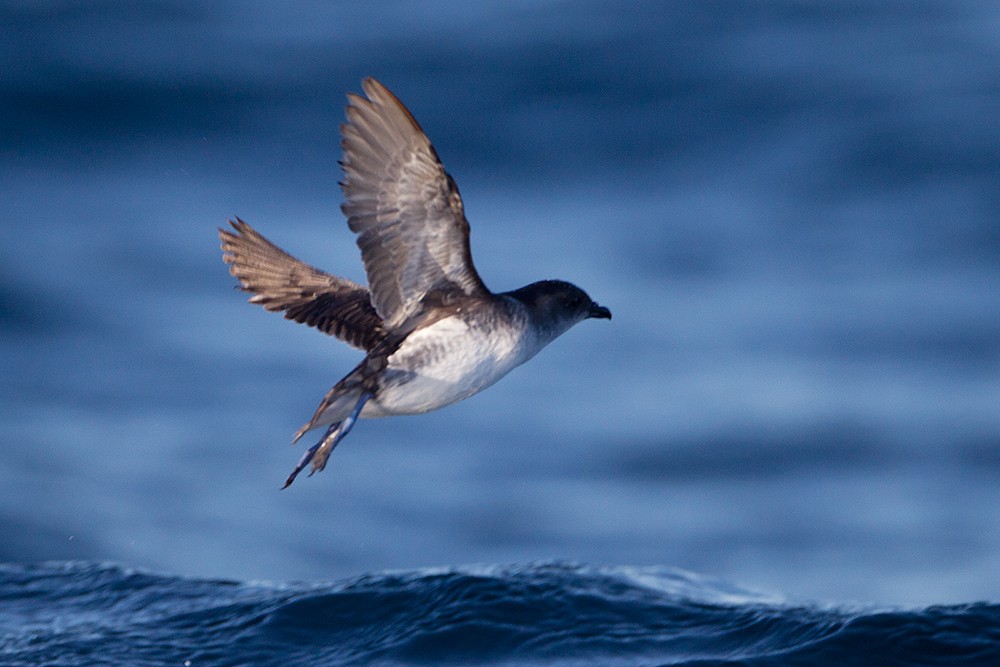Common Diving Petrel
A species of Diving Petrels Scientific name : Pelecanoides urinatrix Genus : Diving Petrels
Common Diving Petrel, A species of Diving Petrels
Botanical name: Pelecanoides urinatrix
Genus: Diving Petrels
Content
Description General Info
 Photo By JJ Harrison , used under CC-BY-SA-3.0 /Cropped and compressed from original
Photo By JJ Harrison , used under CC-BY-SA-3.0 /Cropped and compressed from original Description
The common diving-petrel is a small, plump petrel, 200 to 250 mm (7.9–9.8 in) in length and weighing around 86 to 186 g (3.0–6.6 oz). The plumage is black above and dull white below and it has a relatively short black bill. The wings have thin white strips. The face and neck can be more brown than black. The legs and feet are blue with blackish-brown webbing in between the toes. Unless seen very close, it is almost indistinguishable from the South Georgian diving petrel, P. georgicus. The common diving-petrel has brown inner web primary feathers, whereas the South Georgia petrel has light inner web feathering. Common petrels have smaller and narrower bills than the South Georgia petrel. Another difference is that the South Georgia diving petrel has a posterior black line down the tarsi. The common species is also slightly larger than the South Georgian species. 
Size
25 cm
Colors
Brown
Black
Gray
White
Life Expectancy
6.5 years
Nest Placement
Burrow
Feeding Habits
Common Diving Petrel predominantly consume crustaceans, captured through wing-propelled diving, sometimes reaching depths of 60 meters. They exhibit nocturnal foraging behavior to exploit vertically migrating plankton, showcasing unique adaptations for diving and nighttime feeding.
Habitat
Common Diving Petrel inhabits marine and coastal terrains, especially on oceanic islands with tussock grass and often snow-covered flatlands at breeding onset. Preferred habitats include steep slopes near the sea with substantial vegetation. They range between the broader latitudes of 35 to 55 degrees south, occupying inshore waters and occasionally pelagic zones after breeding. Nesting burrows are usually 1.5 meters deep, situated along coasts or inland.
Dite type
Piscivorous
General Info
Feeding Habits
Bird food type
Behavior
The common diving petrel feeds on the continental shelf during the breeding season, its movements during the non-breeding season are poorly known and whether it disperses more widely is not known. Like other members of their family they catch prey by wing-propelled diving, and are capable of diving to 60 m (200 ft). The diet of this species is dominated by crustaceans. They are known to forage at night on vertically migrating plankton. Feeding is mostly done in the ocean near the shore, but sometimes in the deeper pelagic zone during non-breeding season, which is only 2 months of the year. The mating habits are not well documented, although pairs form monogamous relationships. Breeding colonies are large and there is about one nest per 1 square metre (11 sq ft). The nest is a burrow around 50 cm long with a chamber at the bottom which may or may not be lined with dried grass. Females lay a single white egg, which measures 38 x 29 mm, and is incubated for 53–55 days. The young are brooded for 10–15 days and fledgling occurs at 45–59 days. Both parents take care of the young, which are grey-grown when hatched. The life expectancy is 6.5 years. 
Distribution Area
The common diving petrel is found between latitudes 35 and 55 degrees south, mostly around islands. While the population is decreasing, it is not believed to be rapid enough to be of concern. While 1.5 m (4.9 ft) burrows are usually dug in vegetated slopes, though they are occasionally built in flatland. 
Species Status
Not globally threatened.
Scientific Classification
Phylum
Chordates Class
Birds Order
Albatrosses and Petrels Family
Pelecanoididae Genus
Diving Petrels Species
Common Diving Petrel